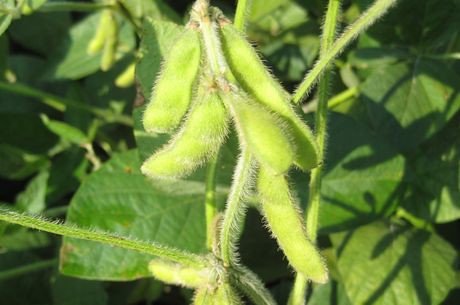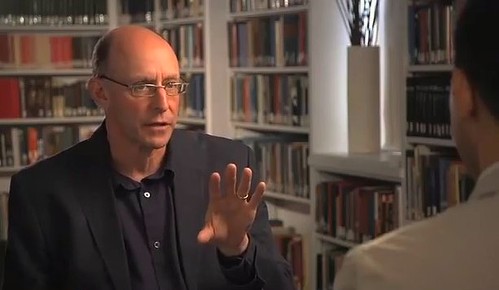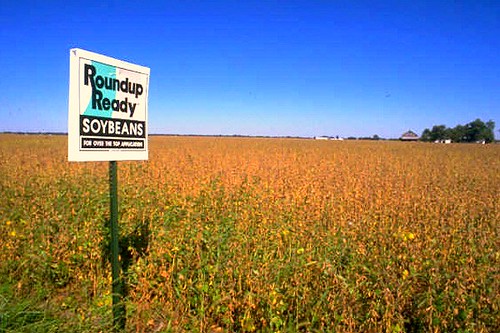Part I. Monsanto’s new Omega-3 soybean: Healthy or hazardous?
The following story was recognized as a finalist in the 2011 SPJ Hawaii Excellence in Journalism Contest for the category of Public Service Reporting.
HONOLULU—On the outskirts of St. Louis, Missouri, Monsanto’s Chesterfield Village Research Center can easily be missed from the freeway—its buildings tucked deep behind long driveways that traverse up a steady hill. Past the security gate and draped in heavy layers of January’s morning snow, the complex appears modest by corporate standards. But perched atop one of the buildings is something different: a monument of glass that stretches the entire length of the roof. This is the greenhouse—the center’s most distinct feature, fitting for a company whose future lies in seeds.
Most tours at Monsanto headquarters begin the same way, with one of its public affairs officers narrating a slideshow of a decidedly uncertain future. Gary Barton, director of biotechnology communications, runs through his pitch without missing a beat: By 2050, experts at the United Nations estimate, the world’s population will increase forty percent, to 9.3 billion people. This means that the two-thirds of the precious freshwater that currently goes toward agricultural production will be taxed even further. The world’s half-billion farmers are already, in a cruel twist of fate, the ones going hungry due to drought. What will be left is a world of depleted resources and countless more hungry mouths to feed.
Monsanto, Barton explains, is working to prevent this awful scenario through research in seed technology. Hence, its corporate responsibility motto, a mantra that would be repeated more than once: Produce more, conserve more, and improve farmer’s lives. Its goals are the opposite of a past that left a trail not so much scattered with seeds as doused with chemicals.

From the late 1920s to the early 1970s, Monsanto produced coolants, flame retardants, and lubricants containing PCBs, a class of chemicals the United States finally banned altogether in 1977 after studies found that they disrupt the endocrine and immune systems and cause severe liver damage (the Department of Health and Human Services now considers PCBs a “probable carcinogen”). Because of the corporation’s poor disposal methods, an entire town—Anniston, Alabama—was, and still is, awash with the deadly compound. In 2003, the company agreed to pay nearly $400 million in reparations to the town’s residents, who now live with the consequences of a chemical that never leaves the body once it enters.
Monsanto also wants us to forget its herbicidal past, including its role in manufacturing Agent Orange. More than forty years after that deadly chemical rained down upon large swathes of North Vietnam, the full range of resultant health defects is still being investigated. Monsanto heavily produced these dioxin-laced herbicides—now known human carcinogens—for the U.S. military, whose planes used the defoliant to clear the dense jungle that camouflaged communist guerillas. In 1984, all of the companies that produced the chemical (including fellow agricultural giant Dow Chemical) reached a $180 million settlement in response to a class-action lawsuit brought upon by U.S. veterans. Since then, more lawsuits have been filed as studies of other health deficiencies linked to the herbicide surfaced. The word Monsanto had become synonymous with corporate irresponsibility.
But in the 1990s, the nearly century-old conglomerate began to reduce its enormous holdings and reinvent itself. In 1997, Monsanto divested its chemicals sector into a new separate company called Solutia. Several years later, it fragmented yet again, when its pharmaceutical arm pulled away and became Pharmacia. What remained was the corporation’s agricultural division, focused primarily on plant biotechnology.
“We’re not ‘the Google search’ with a hundred years of superfund sites and workers’ rights issues and Agent Orange,” Barton declares. “We’re a new company.”
Since shedding its notorious corporate past, Monsanto has honed in on its new role and became the largest seed distributor in the world after its purchase of Seminis in 2005.
“We’re looking to deliver technology in seed,” Barton explains.
The ‘new’ Monsanto
Its highly publicized ambitions—doubling crop yields by 2030, transferring seed technology to struggling African countries, imbuing crops with nutritional benefits—are efforts to paint itself as part of the answer to humanity’s troubles rather than one of its causes. And the “new” Monsanto is starting to make good on at least some of its intentions.
The company has been very busy recently. A type of drought-tolerant corn, critically advantageous in the dry western plains, is nearing commercialization. Through a joint venture with the Bill and Melinda Gates Foundation, the corporation is helping to distribute seed and fertilizer to farmers in Africa (though critics argue that the only purpose to the philanthropy is to open up the market in an area of the world staunchly opposed to biotechnology).
But perhaps most significant for the consumer is the company’s latest commodity, which may arrive on grocery shelves as early as 2012. Monsanto has developed a genetically modified seed designed to do more than repel bugs and kill weeds, but also improve human health. The American Heart Association (AHA) recommends eating a certain kind of Omega-3 fatty acid that decreases the risk for cardiovascular disease, but it’s only found in adequate amounts in the bellies of certain fatty fish. And fish populations, as everyone knows, are collapsing all across the world. Monsanto’s solution is the Omega-3 soybean seed. Genetically engineered to produce a critical compound our bodies can then convert to the heart-healthy fat, the seed could provide a sustainable alternative to a very in-demand nutrient.
Despite the potential good the new soybeans offer, however, many still question or outright dispute their safety. Critics claim that this new generation of genetically engineered foods poses a unique set of additional health risks in addition to the built-in pesticide or herbicide resistant ones already on the market. They say that, as has been the case with previous products, the new soybean seed hasn’t been properly tested, and therefore may pose a danger to human health. Both Monsanto and the Federal Drug Administration, which oversees food safety, have repeatedly brushed off these accusations. In fact, Monsanto famously touts its products as “the most studied foods in the world.”
Meanwhile, the Omega-3 soybean seed has passed all but the final stage of the regulatory process and will almost certainly be approved within a matter of months. To guide consumers who will soon have the option of eating the new soybean oil, which will added to dozens of processed foods, it would be helpful to examine the controversial technology Monsanto employed to create the seed, what might have gone wrong in the process, and whether potential dangers were avoided.
The Omega-3 soybean certainly is new, in the sense that it will be the first agricultural product genetically engineered for nutritional purposes. But if the way it was developed and tested remained the same, will it be any safer than other genetically modified crops?
Food for thought: A history in biotech
From its beginning in 1901, Monsanto held an innocuous business portfolio resembling a who’s who of major chemical, pharmaceutical, and food products widely used throughout the last century.
Founder John Francis Queeny first developed saccharin in 1902, selling the sweetener exclusively to Coca Cola for the following few years. Next came caffeine and Vanillin. Aspirin would fly off the conveyor belt in 1917, and the company would be its leading producer for the next 60 years. Its soirée into fertilizer production began in the 1950s. After acquiring Searle in 1985, the corporation promoted the anti-inflammatory drug Celebrex as well as the ubiquitous artificial sweetener Aspartame.
But it was in 1973 that a scientific breakthrough would propel Monsanto to invest in what is now its financial backbone. Two biochemists, Herbert Boyer and Stanley Cohen, were the first to genetically modify an organism successfully when they inserted genes from one bacterium into another. Realizing the potential, Monsanto arrived on the biotechnology scene in 1979 when developmental biologist Howard Schneiderman was hired to make Monsanto a “world-class molecular biology company.”
In 1983, the corporation was the first in the world to genetically modify a plant, when scientists extracted a gene from E. Coli bacteria and inserted it into the DNA of petunias (this particular gene gave its host immunity to an antibiotic called kanamycin). With this feat achieved, Monsanto began developing what is still its most lucrative product, its Roundup Ready line of seeds, which are inserted with bacterial genes that give them resistance to the company’s best-selling Roundup herbicide.
Since commercializing its very first biotech crop of Roundup Ready soybeans in 1996, Monsanto has almost single-handedly revolutionized industrial agriculture. Instead of having to spray their fields repeatedly with a variety of herbicides, farmers now only have to sprinkle a few applications of Roundup every season. The corporation’s anti-insecticidal line is even more efficient, if not eerier. Its patented Bt corn seeds and cottonseeds contain enzymes (derived yet again from a bacterium) that are toxic to crop-ravaging corn borer caterpillars and cotton bollworms. These pests drop dead upon ingesting any part of the plant.
These innovative seeds, which are both labor and cost-efficient for farmers, have made Monsanto a highly profitable company. Having sold $7.3 billion worth of the technology its last fiscal year (compared to its rival Pioneer Hi-Bred’s $4 billion in sales), the multinational corporation was named Forbes Magazine’s company of the year.
Ninety-three percent of soybeans and 80 percent of corn and cotton planted in American fields now contain Monsanto’s proprietary seed technology.
But a company is only as secure as the duration of its patents. Since the patent for the company’s Roundup herbicide expired in 2000, several companies have brought to market cheaper generic brands, cutting sharply into the company’s profits. After the Roundup Ready soybean patent expires in 2014, other firms like will take advantage of the profitable seed technology by producing their own versions. The only way Monsanto can stay competitive is through continual innovation—making its seeds do more and more novel things. In the Omega 3 soybean seed, Monsanto found its novel thing.
In Part Two of our exclusive report “Monsanto’s New Omega-3 Soybean: Healthy or hazardous?,” The Hawaii Independent‘s Samson Kaala Reiny will look into the process of creating the Omega 3 soybean and examine a source of another controversy that’s unique to the new nutritionally enhanced crops: Not only can plants utilize unique enzymes to produce Omega-3’s fats—they can also produce potentially other dangerous byproducts.

Read Part II of “Monsanto’s new Omega-3 soybean: Healthy or hazardous?” by Samson Kaala Reiny here.

Read Part III of “Monsanto’s new Omega-3 soybean: Healthy or hazardous?” by Samson Kaala Reiny here.